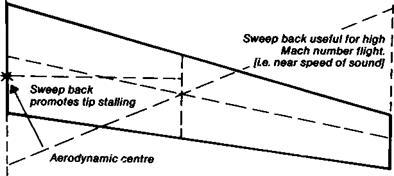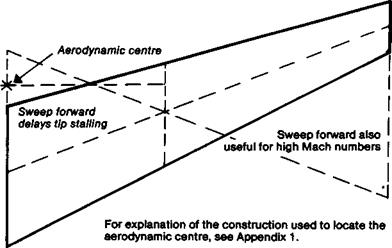SWEPT WINGS
Swept wings, back or forward, are used on full-sized military and commercial aeroplanes because they are beneficial for flight approaching the speed of sound. Low speed aircraft,
|
Fig. 6.5 Swept wings
|
|
|
particularly two seat sailplanes, often use swept wings to assist with balance and cockpit і layout. The rear pilot of a sailplane like the Blanik or Ka 13 needs a view to the sides and і upwards. If the wing is straight, balance requires the rear seat to be close to the main spar of the wing and the view is then seriously restricted. Sweeping the wing forward improves the outlook (Figure 6.5). Tailless aircraft commonly have swept back wings for reasons of stability. (See Chapter 12).
Small amounts of sweep have very little effect on vortex drag. Sweep forward actually aids control at low speeds, delaying wing tip stall, but back sweep has the reverse effect і and control at low speeds may require the use of special devices such as slots, boundary layer fences, etc.
Modellers using pronounced sweep-back as, perhaps, on a scale model of a jet aircraft, ; may find similar devices essential. Sweep-back also has a slight positive dihedral effect and may be justified on aerobatic models which, in the absence of normal dihedral, may find this effect useful for steadier flight both inverted and right side up.
Sweep forward works in the opposite sense, slightly de-stabilising the model in the lateral direction.













